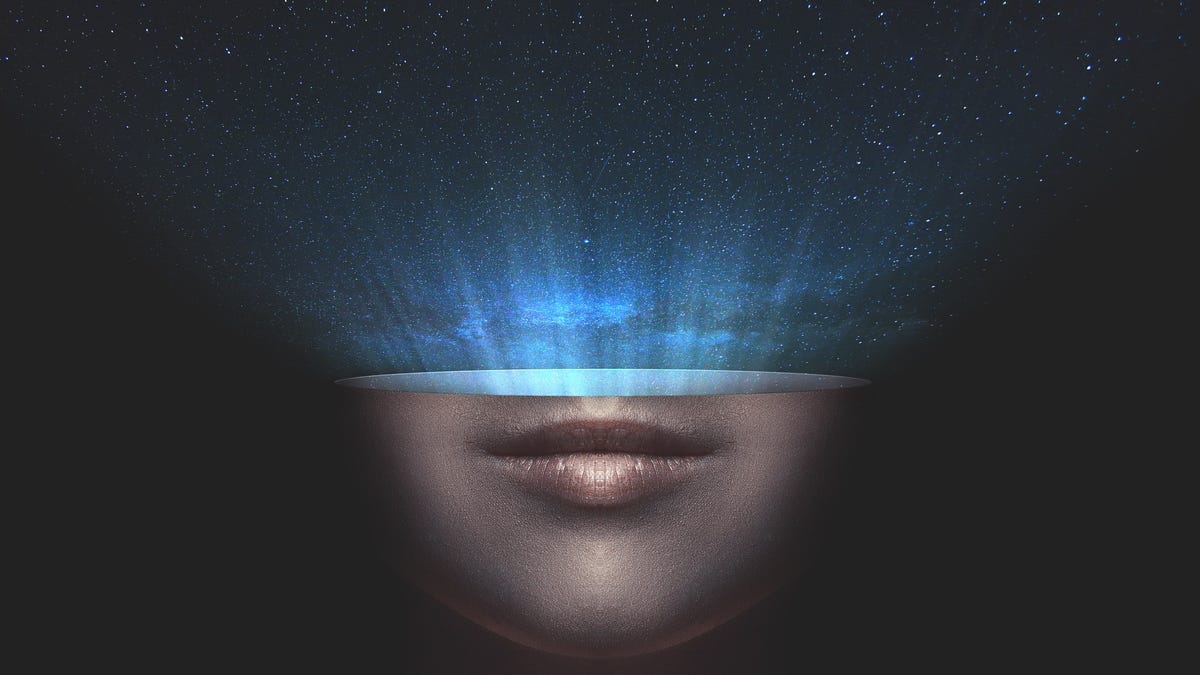
Generative systems use artificial intelligence to create everything from images to building designs.
Public domain
More than seven years ago, CNET invited readers to help write a science fiction novella. The crowdsourced effort took several months and involved contributions from dozens of volunteer writers and editors around the world. Today we could generate a coherent story of comparable length in mere hours — or perhaps a few minutes with the right prompts — using generative artificial intelligence tools like ChatGPT that have captured the world’s attention in recent months.
Even crazier: The illustrations created by CNET artists and others for our crowdsourced novella back then could be done today by AI tools like Dall-E 2 in minutes, and few would notice the difference (the trick is don’t look at the fingers — more on that later).
ChatGPT has already become one of the most rapidly adopted new tech products in history. You’ve probably heard about it being used to help compose everything from emails and cover letters to school assignments. Meanwhile, similar models can generate not just images in countless styles, but also video and even music.
It’s hard to remember anything creating more buzz since maybe Siri or the iPhone. It’s even harder to keep up with it all, so here are some quick answers to all your most pressing questions about generative AI.
What is it?
Despite what even some Google engineers may tell you, chatbots like OpenAI’s ChatGPT or Microsoft’s new Bing bot, which apparently calls itself Sydney, aren’t sentient or conscious. What brought us to this point isn’t magic or an evil conspiracy to enslave us all. Rather, it’s the product of complicated math, code, libraries’ worth of data and a lot of computing power.
The platforms are based on what are called large language models (LLMs) or sometimes generative language models or transformer language models — the GPT in ChatGPT stands for “generative pretrained transformer.” These are machine learning systems that process terabytes’ worth of data, often just scraped directly from the internet, making note of patterns and associations within the dataset, which is called training data.
In the case of ChatGPT, text data sets are enough. Image generators like Dall-E, Stable Diffusion and Midjourney are trained by looking at a wealth of images and learning what they are by reading captions that accompany them, so the models still rely on language.


This image is the result of prompting Dall-E 2 with “paint me a picture of Dall-E painting a picture of Dall-E painting a picture.”
Eric Mack/CNET/Dall-E 2
A neural network is a type of machine learning system that can be trained on tons of data and can then spit out insights from the patterns. Such a neural net isn’t new. What’s happening with publicly available generative systems that have debuted in the past year is that these patterns are not only learning, they’re also then paired with a second neural network that reverse engineers the process to create content and checks it against the first neural net to make sure it matches the prompt given to the system.
In essence, you give ChatGPT or Dall-E a prompt and they formulate a response by predicting what the next word (or pixel in the case of an image) should be based on all the patterns and associations gleaned from training data.
What else can LLMs do?
In addition to generating text and images, other AI systems, like Runway’s Gen1 and Meta’s Make-a-Video, generate video effects, filters and entire scenes through similar means.
Recently, Google’s research arm released an early version of MusicLM, which can take text-based prompts and transform them into samples of music. The results are impressive.
Generative systems are also being used to create code and 3D designs for all sorts of objects, from clothes to buildings. Theoretically, if there’s a form or medium of content or even just a dataset out there ample enough to train an AI on, then AI should be able to generate that kind of content on its own.
IBM is using generative systems to develop new semiconductors and molecules that can help fight cancer or bacterial infection. There may be no limit to what can be generated, which is both exciting and a little terrifying at the same time.
How can I use this stuff?
There’s arguably a rapidly inflating AI bubble, with startups suddenly claiming to use AI to generate everything from more spam emails for business leads to entire marketing videos. People are certainly having fun with chatbots and image generators, and some creatives are finding the tools helpful when working on concepts or early drafts of new work.
Adjacent forms of AI have been quietly revolutionizing things like weather forecasting and medical imaging analysis.
A rarely mentioned advantage of the current state of AI is that it’s remarkably good at things that would take humans years to complete, like processing the entire canon of a certain literary or artistic movement or grokking the tonal structure of a certain genre of music. At the same time, some of AI’s weak points — understanding complex contexts, acting in unpredictable or innovative ways and evaluating emotions or sensory inputs — are things humans excel at with little to no effort.
Many uses of this technology may lie in new ways of collaborating with AI to accentuate what both biological and artificial intelligence do best.
How can you be sure it isn’t sentient?
Simple, really: Information isn’t knowledge. LLMs are kind of like having a reference librarian who can go beyond just pointing you to the right section of the library — she can quote you any line from any book in the library because she’s read and memorized them all. But there’s a problem. This seemingly perfect librarian has never done anything else but read everything in the library.
Her lack of life experience makes it difficult for her to correctly interpret the contexts, subtexts, intentions and other less-than-literal nuances behind each word she ingested. What’s worse: The same goes for her ability to correctly understand the questions and prompts she gets from library patrons. So she often gets things wrong.
It’s as if the entirety of the written word was memorized by a single person ready to answer our questions about anything. The only catch is that the person also happens to be an alien.
Plenty of users of ChatGPT have noticed frequent factual errors and inconsistencies in the responses the system gives. This is because it’s trained on a wealth of data that hasn’t been fact-checked and it doesn’t fact-check itself, it just predicts what word should be next based on everything it’s read. It literally has no common sense. This can lead to errors, something that CNET itself has experienced in using a generative AI model.
Weird things also happen with image generators, which have a really hard time counting, among other things. Figures with the wrong number of fingers are comically common.


Don’t look too close at the fingers (or the eyes). This is the result of trying to extract a self-portrait from Dall-E 2 with the prompt “journalist eric mack writing about generative AI using his laptop in a coffee shop.”
Eric Mack/CNET/Dall-E 2
So there are problems, right?
There are risks that every new technology and tool will be used for ill, and with AI there are still a lot of unknowns, which makes it a bit more scary. You’ve probably already heard concerns from teachers who see students submitting AI-generated assignments, or writers and other creatives concerned about being replaced by AIs that work cheaper and faster than people.
All these concerns are valid and perhaps indicative of a new reality in which we must become familiar with some of the tells that content has been generated by AI, like the eyes and fingers in the above image. Of course, just as we get the hang of this, it’s likely that the AI generators will get better and the work they produce will become harder to discern from human-generated work.
There are also a number of unanswered ethical and legal concerns. A handful of artists are suing some of the companies behind AI image generators, claiming that their artwork was scraped from the web to train the systems without permission and that they may be entitled to compensation. Getty Images, which CNET and many other media outlets contract with to license imagery for content, has filed a similar suit seeking over a trillion dollars in damages.
And this is just the beginning, because generative AI systems are in a way a reflection of the entire internet. This means that racism, sexism and other kinds of bias and nastiness can sneak into the results, despite the platforms’ best efforts to control for it. There are also privacy concerns along similar lines and the disturbing notion that a “poison pill” could be slipped into training data to manipulate results. Fake news generated by bots on social media like we’ve seen in recent years is one thing. Imagine if a chatbot used by millions or billions started spewing fake or manipulated responses because it had been trained on tainted data.
Should I be freaked out, then?
It’s understandable if you’re troubled or overwhelmed by all this. It’s a lot, and it hit the culture quickly over a short period of time. There are some things I’ve been telling myself about the essential nature of humans that I find consoling, at least in the short term.
First, there’s the question of how creative LLMs really are. Image generators can start to become repetitive, and they also lack the spark of inspiration and a certain amount of intention that we love to guess about when observing a human-generated work of art. In fact, that’s the whole point of prompting these systems; they’re designed to rely on humans for intent and inspiration.
Of course, there may be ways to tweak AI to be more creative on its own, by asking it, for instance, to specifically generate new content based on weaker associations it finds in training data. This could be a way of simulating human creativity using math and code. But anyone who’s ever had a creative breakthrough or a eureka moment in the shower will tell you that it often seems to come from nowhere.
We don’t yet understand our creativity ourselves, so we can’t yet translate it into code that a machine can understand and try to replicate. This is to say nothing of human emotions, many sensory experiences or much of the basic function of the brain that still isn’t well understood by science.
Then again, this is just the beginning. Some believe we’re careening toward artificial general intelligence in the next decade or two — this would be a system that really does have the same abilities as a human in an indistinguishable way. For the record, other experts think this won’t happen for a long time, if ever.
For the moment, the best thing to do is to become familiar with these systems, how they work and what they can and can’t do. Knowledge is more powerful than just information, even terabytes of it, and that’s one advantage we all still hold over AI. At least for now.
Editors’ note: CNET is using an AI engine to create some personal finance explainers that are edited and fact-checked by our editors. For more, see this post.
